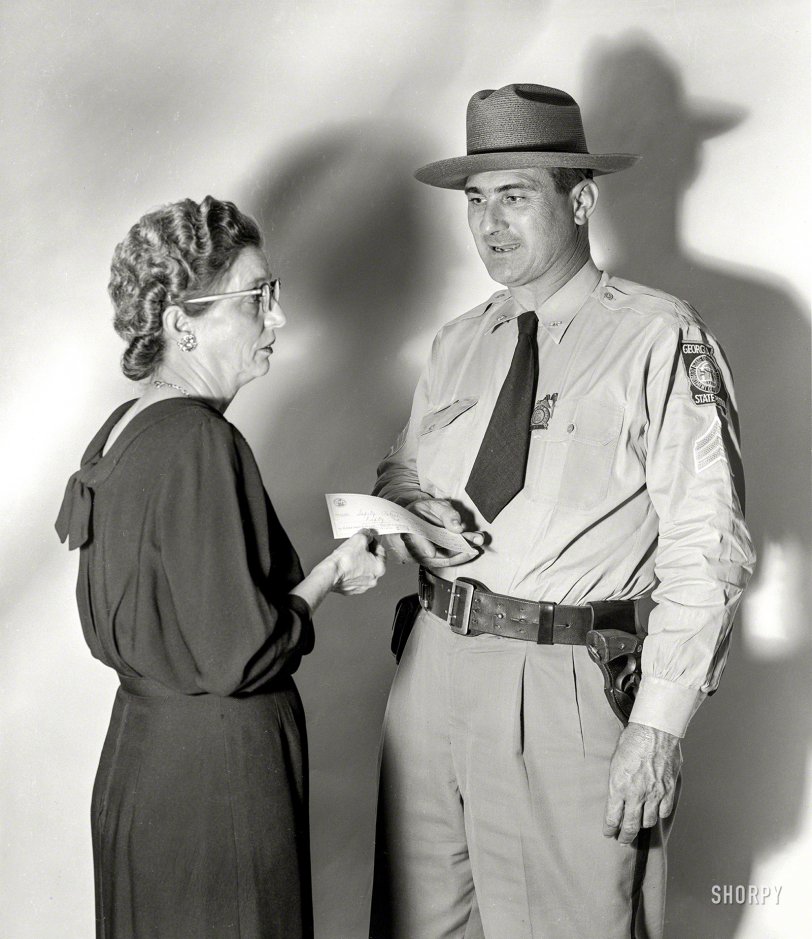


Framed or unframed, desk size to sofa size, printed by us in Arizona and Alabama since 2007. Explore now.
Shorpy is funded by you. Patreon contributors get an ad-free experience.
Learn more.

- Complicated then, forgotten now
- Bryan-Stevenson
- Skinny is as skinny does
- How do you rest in peace
- Riding the footboards
- Alas, hidden from view
- Baldwin Diesels
- Exclusive pump
- Bananas, Oysters and Smokey Joe
- Details, Details
- What's that building to the left of the tower?
- Coal Barges
- Bromo-Seltzer
- Inner harbor
- The Basin
- What a headache!
- Giant stepladder?
- Yeah, it was cold
- Love those coats
- Link & Pin Days Remnant
- Baldwin 62303
- Baldwin VO-1000
- Cold
- No expense spared
- Tough Guys
- What's your hurry, where's your hat?
- Sheriff's Signature
- Relocated in the Eighties
- Lost in Toyland
- And without gloves
Print Emporium
Fifty for Safety: 1949

"Now I can afford a longer necktie!"
Columbus, Georgia, circa 1949. "Safety Patrol Fund." A $50 check to Sergeant 97 of the Georgia State Patrol. 4x5 inch acetate negative. View full size.
Cross draw
The holster on the trooper isn't actually a cross draw holster. It's a standard strong-side holster that has been moved to the other side. They (cross draws) are still popular with detective-types and the like and they can be handy if seated in a vehicle. There are a number of reasons that cross draw holsters are no longer favored, especially for uniformed use. First, it usually required two hands to remove the firearm, one to release the retention strap and the other to reach across to draw. Modern strong side holsters only require the use of the shooting hand to disable the retention devices and draw the firearm. Additionally, the firearm is in the perfect position for a disarm attempt from a person facing the officer. Retention devices of the day didn't provide much security and were easily defeated by such attempts. When I started in 1977, cross draw was the norm for uniform use in my part of the country.
What safety was priced at $50 in 1949?
$50 in 1949 was a lot of money. Aside from that- he looks like he could be LBJ's brother.
Quick draw McGraw
The reason you don't see PD cross draw setups is because the modern police holster has to be pushed down to remove the pistol. This prevents a prisoner from grabbing it even if the cross strap is loose.
Crossdraw is situational
I used to correspond with Elmer Keith, who knew a thing or two about sixguns, and he said crossdraw was often better for big men or for officers who might have a prisoner on their right side in a car or situations like that.
I don't see it done nowadays that often.
No ya-hoo
With respect, I would hesitate to apply modern sensibilities to a post-war Georgia State Police sergeant and doubt his manner of carry was frowned upon by anyone. He likely knows exactly how to handle that revolver.
Crossdraw
Interesting that the officer has his revolver in the butt-forward, "crossdraw" position. This was often frowned upon because it required the user to wave his gun through a 120-degree arc, possibly past innocent people, before pointing it at his intended target.
























On Shorpy:
Today’s Top 5